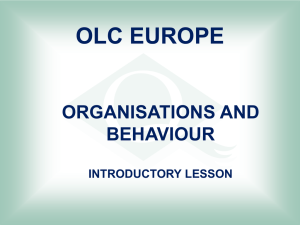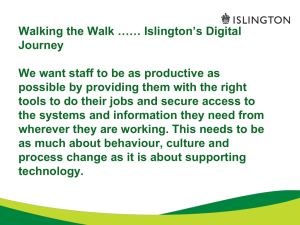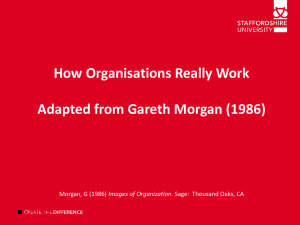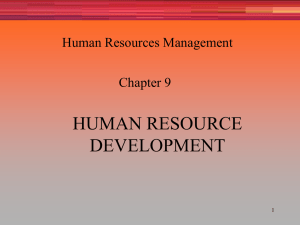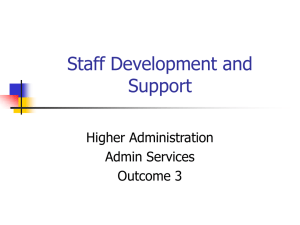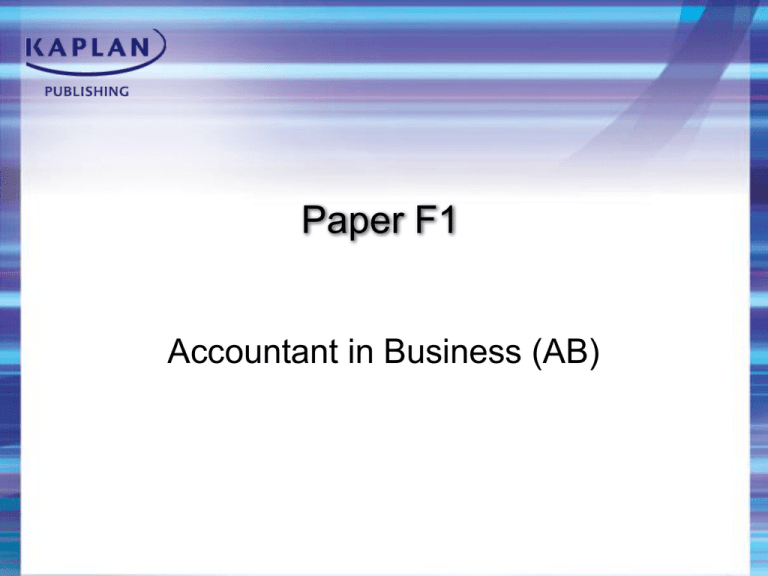
Paper F1
Accountant in Business (AB)
1. THE BUSINESS
ORGANISATION
The need for organisations
Organisations are social
arrangements for the
controlled performance of
collective goals
Two or more people working
together in a structured way.
Organisations use systems
(e.g. swiping in when
entering office) and
procedures (e.g. cash
handling rules) to regulate
staff behaviour
All organisations pursue
certain goals and these are
considered to be over and
above individual aspirations
Types of organisation
Profit seeking organisations
Not for profit organisations
Main objective is wealth maximisation
which can be expanded into
• to continue in existence (survival)
• to maintain growth and development
• to make a profit
Do not see profit as their main
objective
• seeking to satisfy particular needs of
their members or the sectors of
society that they have been set up to
benefit
• include hospitals, charities,
government organisations and mutual
organisations
The roles of organisational
functions
Departments and
their roles
HR –dealing
with staff
issues
Finance –
financial
reporting,
treasury and
management
accounting
Admin –
back office
supporting
functions
Services –
customer
services,
dealing with
complaints
and
enquiries
Marketing –
product
design,
pricing,
distribution
and
promotion
Production –
converting
supplies into
finished
goods and
adding value
in the
process
Purchasingacquiring
input
materials
and
negotiating
trading terms
R&D–
developing
and
improving
products
Planning Levels
Strategic
•Long term
•Looks at the whole organisation
Tactical
•Medium term
•Looks at the department/divisional
level
Operational
•Short term
•Concerned with the day to day
running of the organisation
2. ORGANISATIONAL
STRUCTURE
Different Structural Types
Type
Rationale
Entrepreneurial
Typical in small owner
managed companies.
Functional
Departments are based on
common specialisation.
Best suited to companies
operating in a stable
environment with few
products.
Divisional
Each product or group of
products set up as a
separate division.
Geographical
Activities are grouped
according to location.
Matrix
A combination of the
functional and divisional.
Dual reporting lines
Centralisation/Decentralisation
Centralised structure
Decentralised structure
The upper levels of an organisation’s
hierarchy retain the authority to make
decisions
The authority to take decisions is
passed down to units and people at
lower levels. Can lead to extra costs in
obtaining information
Better motivation due to increased
training and career path
3. ORGANISATIONAL
CULTURE
Organisational Culture
A set of
norms of
behaviour.
Formal and
informal rules
Organisational
Culture
A set of
shared values
and dominant
beliefs
Symbols and
symbolic
actions
Handy’s cultural Types
Power
Found in smaller
entrepreneurial
organisations
One major source of
influence (the founder)
Task
Project based, creative
work
Nothing is allowed to get in
the way of achieving the
goals
Role
Common in bureaucratic
organisations (e.g.
Government)
Emphasis on position
within the hierarchy
Person
Built around educated and
articulate individuals –
specialists with a common
interest
Schein – 3 levels of culture
Artefacts
• The aspects of culture that can be
easily seen e.g. the way that
people dress
Espoused
values
• The strategies and goals of the
organisation including company
slogans etc.
Basic
assumptions
and values
• difficult to identify as they are
unseen and exist mainly at the
unconscious level
Hofstede - 5 cultural traits
Individualism
v collectivism
Uncertainty
Masculinity v
femininity
Power
distance
Confucianism
v dynamism
2.LEADERSHIP, MANAGEMENT
AND SUPERVISION
Theories of management
Classical
theories
• Taylor
• Fayol
Human
relations
school
• Elton Mayo
Modern
approaches
• Mintzberg
• Drucker
Authority, responsibility and
power concepts
• Authority is a legitimate right to give
orders
• Responsibility is an obligation placed on
a person to fulfil a task
• Power is an ability to exert influence.
Sources can be legitimate, reward,
coercive, referent or expert
• Delegation is a process of transferring
authority to a subordinate
Leadership
Trait Theories –
Early studies
focused on
personality
Transformational
Theories – focus
on change
management
Bennis , Heifetz
Leadership
Behavioural
Theories – focus
on human
relationships
Blake and
Mouton,
Ashridge
Contingency
Theories – No
one leadership
style is right for
every set of
circumstances
Fiedler, Adair
5. INDIVIDUAL AND GROUP
BEHAVIOUR IN BUSINESS
ORGANISATIONS
Individual and Group Behaviour
Individual
or
team/group
Passive
Behaviour
Assertive
Aggressive
6. TEAM FORMATION, DEVELOPMENT
AND MANAGEMENT
Teamwork
• A team is a formal group, it has a
leader, a distinctive culture and is
geared towards a final result
• The purpose of a team is to solve
complex problems
• Teams provide synergy, cooperation
and coordination of activities
Team v Group
Team
Group
• Share a common
goal
• High level of
commitment
• Team spirit
• Healthy competition
• Can be multi skilled
or multi disciplinary
• Interests change
frequently
• Membership is often
temporary
• People negotiate
and accommodate
• Politics is common
Team Theories - Belbin
Leader
Co-ordinator
Shaper
Promotes activity dominant
Plant
Thoughtful and thought
provoking
Monitor evaluator
Criticises other ideas
Resource-investigator
Extrovert, networker
The company worker
Administrator, organiser
The team worker
Concerned with
relationships within the
groups
The finisher
The progress chaser
The expert
As required by the project
Team theories - Tuckman
Forming
Storming
Norming
Performing
7.MOTIVATION
Overview of Motivation
• Motivation is the internal psychological
process of initiating, energising,
directing and maintaining goal directed
behaviour (Buchanon and Huczynski,
1997)
• It is the urge to achieve goals or the
drive to excel
• Satisfaction on the other hand is about
being content and not seeking new
achievements
Content theories of Motivation
• Maslow’s hierarchy of needs –
individuals have a hierarchy of personal
needs that can be satisfied in a set
order of priority in the workplace
• Herzberg two factor theory – hygiene
factors deal with non-job related
features e.g. working conditions,
policies and procedures. Motivators are
mostly non financial and will encourage
people to work harder
Maslow’s hierarchy of needs
• Challenging job, creative task
Self
fulfilment demands, achievement in work
Ego
Social
Safety/Security
Basic/Physiological
• Merit pay increase, high status
job title
• Compatible work group,
friendships at work
• Job security, fringe
benefits
• Basic salary, safe
working conditions
Herzberg’s two factor theory of
motivation
Dissatisfied and
demotivated
H
No longer
dissatisfied but
not yet
motivated
M
Satisfied and
motivated
McGregor’s Theory X and Y
Theory X
• Human beings have an
inherent dislike of work and
will avoid it if possible
• People must be coerced,
controlled, directed or
threatened with punishment
to get them to contribute
towards organisational
objectives
• People prefer to be directed,
wish to avoid responsibility
and want security above all
else
Theory Y
• Physical and mental effort in
work is totally natural, people
not only accept but seek
responsibility.
• Staff will exercise self
direction and self control to
achieve objectives to which
they are committed
• People possess a high level
of imagination and creativity
in the solution of
organisational problems
Process Theories
• The Vroom expectancy model
• Force = Valence x Expectancy
• Force is the strength of a persons
motivation
• Valence is the strength of an individual’s
preference for an outcome
• Expectancy is the probability of success
Incentive Schemes
• Reward systems should attract and
retain staff, encourage desirable
behaviour and reflect the nature of the
job
• Financial motivators include salary and
bonus
• Non financial motivators include
feedback, participation and autonomy
8. INFORMATION
TECHNOLOGY
Information and Data
• Data is a collection of symbols, raw
facts and transactions that have been
recorded but not yet processed. It could
be quantitative or qualitative
• Information is data that has been
processed in such a way that it
becomes meaningful
• Information is used for decision making
at the strategic, tactical and operational
levels
Qualities of good information
Accurate
Easy to
Use
Timely
Complete
Good
information
Cost
effective
Understandable
Adaptable
Relevant
Computerisation
•
•
•
•
Intranet
Extranet
Database
Spreadsheet
Sources of information
• Internal information includes customer
records, employee records, inventory
and product specifications
• External information includes invoices,
letters, statements from 3rd parties etc
• External information can also be
obtained through marketing research,
legal updates and government data
Types of information system
Transaction
Processing System
(TPS)
Management
Information System
(MIS)
Executive
Information System
(EIS)
•Looks at individual
transactions
•Routine reporting
e.g. Payroll
•Used by junior
management
•Concerned with
recording and basic
processing
• Converts data from
TPS into information
• Used by middle
management
•Generates ad-hoc
reports
•Concerned with
monitoring
performance and
coordination
•Concerned with
monitoring business
results and general
business conditions
• flexibility in data
reporting, including
drill down facility
•Includes data from
internal and external
sources
•Used by senior
management
Decision Support
System (DSS)
Expert System
(ES)
•Modelling tool which
requires significant
expertise to use
•Performs what if
analysis
•Supports semi
structured and
unstructured
decisions
•Includes statistical
instruments
•For e.g. Bank loan
approval
•Contains a
knowledge database
•Can be used at any
management level
•Relies on a set of
rules to solve a
problem
•Can be used to
automate manual
processes
9.POLITICAL AND LEGAL
FACTORS
Political Factors
Political environment includes:
• the political system and ideology
• the role of the government in the
economy
• the risk of political instability
• foreign trade relationships
Political systems operate on a global,
national and local level
Legal Factors
Data
protection
Health and
safety
Employment
law
10. MACROECONOMIC
FACTORS
Economic factors
• Microeconomics is the study of the
economic behaviour of individual
consumers, firms and industries
• Macroeconomics considers aggregate
behaviour and the study of the sum of
individual economic decisions.
Factors affecting the level of
business activity
• consumer and business confidence in
the economy
• aggregate demand:
AD = C + I + G + X – M
• availability of capital
• use of resources such as technology
• government policy on spending and
taxation
• exchange rate movements
Trade Cycle
• A series of fluctuations in the rate of
growth of real (inflation adjusted) GDP
over its long-run trend
• Recession
• Depression
• Recovery
• Boom
• Government tries to smooth pattern out
Key economic terms
•
•
•
•
•
•
Economic growth
Inflation
Unemployment
Balance of payments
Fiscal economic policy
Monetary policy
11. SOCIAL AND
TECHNOLOGICAL FACTORS
Social Factors
• Population (e.g. birth rate and growth)
• Wealth (e.g. high disposable income)
• Education (e.g. skilled staff thrive in
knowledge economy)
• Health (e.g. obesity, HIV)
• Cultural trends (social structure, buying
patterns, values, attitudes, tastes)
• Affected by government policy
Technological factors
Impact of technology on:
• organisational structure (e.g.
downsizing, outsourcing)
• products (e.g. sophisticated features)
• production processes (e.g. automation)
• society (e.g. ecommerce, homeworking)
12.COMPETITIVE FACTORS
Competition – Porter’s generic
strategies
• Cost leadership: to become the lowest
cost producer and enjoy a superior
margin
• Differentiation: demanding a premium
for perceived added value of the
product
• Focus: Serving a niche market
Being ‘stuck in the middle’ is a recipe for
disaster
Porters 5 Forces
Threat of
New
Entrants
Power of
Buyers
Competitive
Rivalry
Threat of
Substitutes
Power of
Suppliers
Porter’s Value Chain – primary
activities
Activity
Description
Inbound logistics
Receiving, storing and handling raw
materials
Operations
Transformation of raw materials into
finished goods
Outbound logistics
Storing, distributing and delivering
finished goods to customers
Marketing and sales
Market research and the 4 P’s
Service
All activities occurring after the point
of sale e.g. training, repair
Porter’s Value Chain – support
activities
Activity
Description
Firm infrastructure
How the firm is
organised
Technology
How the firm uses
technology
HRM
How people contribute to
competitive advantage
Procurement
Purchasing, not just
limited to materials
13. STAKEHOLDERS
Stakeholders
Internal
Connected
Stakeholders
Conflict
External
Mendelow’s stakeholder
mapping
Low
Minimal
Effort
Keep
Informed
Keep
Satisfied
Key
Players
Power
High
Low
Level of Interest
High
14. COMMITTEES IN
BUSINESS ORGANISATIONS
Committees
A committee is a group of people officially
delegated to perform a function and
who are given appropriate authority.
Types of committees:
• Ad-hoc
• Standing
• Sub-committee
• Joint
Types of Committees continued
•
•
•
•
•
•
Executive
Steering
Work safety
Ethics
Audit
Remuneration
15. BUSINESS ETHICS
Business ethics
• Ethics is the analysis of right and wrong
and associated responsibility
• Business ethics is the systematic study
of moral matters pertaining to business,
industry or related activities, institutions
or practices and beliefs
• Two approaches to ethics, either a
compliance-based approach or an
integrity based approach
Code of professional conduct
ACCA’s code of ethics:
• Integrity
• Objectivity
• Professional competence and due care
• Confidentiality
• Professional behaviour
16. GOVERNANCE AND
SOCIAL RESPONSIBILITY
Board of Directors
• At least half of the board should
comprise independent non-executive
directors (NED’s) who do not engage in
day to day execution of management
decisions
• NED’s contribute to strategy
formulation, monitor performance
reporting, ensure robust financial
controls and determine executives
remuneration
Corporate Governance
• The system by which companies are
directed and controlled
• UK – Combined Code is principles
based, company must ‘comply or
explain’
• USA – Sarbanes Oxley is rules based
(i.e. law) with personal liability of
company officers
Social Responsibility
• Social responsibility is a duty to all
stakeholders of the company to make
decisions in such a way that takes into
account the interest of the environment
and society as a whole
• Benefits include, attracting customers,
reducing operational risks and retaining
employees
17. LAW AND REGULATION
GOVERNING ACCOUNTING
Regulations covering
accounting function
Responsibility to:
• Companies House (for filing of
accounts)
• Tax Authorities (e.g. HMRC for VAT,
PAYE)
• Financial Services (e.g. stock exchange
for listed co’s)
• Office of national statistics (e.g.
business statistics)
Bodies governing the
accounting function
• International Accounting Standards
Committee foundation, parent entity of:
• International Accounting Standards
Board (IASB)
• International Financial Reporting
Interpretation committee (IFRIC)
• Standards Advisory Council (SAC)
Other bodies
• Accounting Investigation and Discipline
Board (AIDB)
• Financial Reporting Review Panel
(FRRP)
• Professional Oversight Board for
Accountancy (POBA)
• Recognised Supervisory and Qualifying
Bodies (e.g. ACCA, ICAEW)
18. THE ACCOUNTING
PROFESSION
The role of accounting within
the business
• Not a ‘stand alone’ function
• Interacts with other departments and is
one of the central functions of business
• Financial information is a fundamental
requirement in decision making
Purpose of accounting function
• Produces financial information that will
be used to make decisions
• May be produced for users outside the
company e.g. sales invoices, financial
statements
• May be produced for users inside the
company e.g. ledgers, cost information
19. ACCOUNTING AND
FINANCE FUNCTIONS
Modern accounting function
Structure of accounting function:
• Financial Accounting (maintaining
books and records, preparing accounts)
• Management Accounting (appraisal,
budgeting)
• Treasury (cash management, tax
affairs)
• Auditing (reviewing financial reports and
internal controls)
Recording of transactions
Transactions
Day Books
Ledger
accounts
Financial
statements
20. FINANCIAL SYSTEMS AND
PROCEDURES
Financial Procedures
Stages in:
• Sales cycle
• Purchasing cycle
• Wages cycle
• Cash system
• Inventory system
The purpose of organisational
control
Purpose
Why important
Safeguard company’s assets
If assets are stolen or damaged the
company will have to spend money to
replace them
Efficiency
Inefficient business practices are a
waste of the company’s money
Prevent fraud
Fraud means the loss of valuable
resources belonging to the company
Prevent errors
Errors can lead to losses in efficiency
(time spent correcting) or a loss of
assets (e.g. paying for goods that
weren’t received)
21. THE RELATIONSHIP OF
ACCOUNTING WITH OTHER
BUSINESS FUNCTIONS
Coordination between accounting
and other business functions
Purchasing
• Establishing credit terms
• Monitoring payments
Production
• Cost measurement and overhead allocation
• Budgeting
HR
• Recruitment and training expenditure
• Reward plans, tax efficient benefit packages
IT
• Systems design and development
• Improving access to information
Customer Services
• Pricing additional services
• Assessing costs of product failures
Marketing
• Advertising budgets
• Product pricing
Marketing
• Defined by the Institute of Marketing as
‘the management process that
identifies, anticipates and supplies
customer needs efficiently and
profitably’
• Key emphasis on customer needs
• Marketing research, product
development, distribution and promotion
all important
Marketing Mix
Product
• This includes product features, durability,
design, brand name, packaging, warranties and
guarantees
Place
• Choice of distribution channels, transportation,
outlet management, stocks and warehouses
Promotion
Price
• Advertising, personal selling, publicity, sales and
promotion techniques
• Price levels, discounts, allowances, payment
terms and credit policy
22. INTERNAL AND EXTERNAL
AUDIT
Internal and External Audit
• Internal auditing is an independent
activity, established by management, to
examine and evaluate organisational
risk, management processes and
control systems and make
recommendations for improvements
• External auditing is an independent
examination of the financial statements
to see whether they give a true and fair
view of the company’s affairs
Internal and External Audit differences
Internal Audit
External Audit
Roles
Advises management on
the strength of internal
controls and protecting
the organisation against
loss
Provides an opinion to
the shareholders on
whether the financial
statements give a true
and fair view
Legal Basis
Not a legal requirement,
but highly recommended
by The Combined Code
Legal requirement for
most companies and
public bodies
Scope of Work
Determined by
management
Determined by auditing
standards
Approach
Evaluates and
Tests items and
recommends
transactions in the
improvements to controls financial statements
Status
Company employees
Independent
accountants
23. INTERNAL FINANCIAL
CONTROL
Internal Controls
Internal Control is a process designed and initiated by
management to provide reasonable assurance about
the achievement of the entity’s objectives with regards
to:
• reliability of financial reporting
• effectiveness and efficiency of operations
•compliance with laws and regulations
Internal controls are checks on day to day transactions.
They are managements responsibility.
Components of Internal Control
Control
Environment
• Overall attitude of management to internal
controls
Risk assessment
process
• How the company identifies and responds to risk
Information
Systems
• Procedures to process transactions and maintain
control over assets, liabilities and balances
Control Activities
Monitoring of
controls
• Policies to ensure management directives are
carried out
• Assessment of internal control performance over
time
Categories of Internal Control
Authorisation
Physical
Comparison
Controls
Internal
Controls
Computer
A
ccounting
Reconciliations
Controls
M
aintaining
a trial balance
Arithmetical
Controls
Types of Control
Preventative
• segregation of duties
• screening of new personnel
Detective
• reconciliation
• supervision
Corrective
• data back ups
• follow up procedures
24. FRAUD
Fraud
• Fraud is an intentional act involving the
usage of deception to obtain an unjust
or illegal advantage. It is a criminal
offence
• Prerequisites include: dishonesty,
motive and opportunity
• Fraud could be committed by
management, employees or third
parties
Examples of fraud
Management
fraud
• window dressing
• misappropriation of assets
Employee
fraud
• teeming and lading
• skimming schemes
Third party
fraud
• false billing
• advance fee fraud
Implications of fraud
•
•
•
•
Company collapse
Adverse publicity
Reduced profits
Qualified audit report since financial
statements do not give a true and fair
view
• Distorted performance results make it
hard for managers to make business
decisions
Responsibility for preventing
fraud
Directors
Employees
External
Auditors
• Required by the combined code to maintain a
sound system of internal control
• An implied duty to act honestly and report
suspected actual fraud
• Specific duties in employment contract
• No duty to find fraud but may act as a deterrent
• If financial statements materially affected by
fraud, audit report will be qualified
IT systems security
Risks to data:
• Human errors
• Technical malfunction (e.g. systems
crash)
• Natural disasters (e.g. fire, flood)
• Sabotage or espionage
• Malicious damage
Principles of data security
• Use individual and complex passwords
• Secure communication channels (e.g.
fire walls)
• Back up information on a regular basis
• Have a contingency plan
• Physical security for documents
• Policy on suspicious emails
25. RECRUITMENT AND
SELECTION
Recruitment and selection
• Recruitment is the process of
generating a supply of possible
candidates for positions within an
organisation
• Selection is choosing from a number of
candidates the one most suitable for the
specified position
Recruitment process
Importance of R&S
Consequences of poor R&S
• New recruit will be technically
competent and able to perform the job
• High staff turnover
•Wasted advertising budget
• Effective R&S reduces the need for
retraining
• Employee will bring in ideas and
enhance productivity
•Candidate will get on well with
existing team
•Process will comply with legal
requirements reducing employee
disputes
•Loss of management time dealing
with unsuitable candidates
•Costs and demoralising effects of
dismissal
•Increased workload on existing staff if
new recruit makes mistakes
• Potential effect on efficiency of
operations
Job Analysis
• The process of collecting all relevant
information about the position
• This information is then summarised
into:
1.Job description
2.Person specification
3.Job evaluation
Selection Process
Selection tools include:
• Interviews
• Tests (e.g. aptitude, proficiency)
• Assessment centres
• References from previous employer
Types of Interview
•
•
•
•
Face to face
Successive Interviews
Group interviews
Panel interviews
Equal opportunities and
Diversity
• Equal opportunities is normally
delivered through legislation which is
aimed at giving all people an equal
chance to be treated fairly in all aspects
of employment
• Diversity relates to valuing everyone as
an individual and recognising the
differences as contributing factors of
business success
Equal Opportunities legislation
Equal pay
Sex discrimination
• Aims to eliminate differentials in pay and terms and conditions
of employment between people in similar positions
• Prohibits discrimination on the grounds of sex and marital
status. Identifies four forms of discrimination: direct, indirect,
victimisation and harassment
Racial
discrimination
• Outlaws discrimination on the grounds of colour, race, ethnic or
national origin. Exemptions include genuine occupational
qualifications
Disability
discrimination
• Companies must make a reasonable adjustment to
accommodate special requirements of disabled staff
Age
discrimination
• Prohibits unjust age discrimination, removes compulsory
retirement age
26. REVIEW AND APPRAISAL OF
INDIVIDUAL PERFORMANCE
Appraisal
• Appraisal is a regular and systematic
review of performance and assessment
of potential with an aim of producing an
action programme to develop both work
and individual
• Its purpose is to review performance,
potential and pay
Objectives of appraisal
From organisational point of view
From individual point of view
• Establishes the results staff are
expected to deliver
•Identifies training and development
needs
•Encourages communication
•Aids personnel planning
•Creates a supportive organisational
culture
•Determines future promotional
activities
•Gives recognition for work well done
•Serves as a basis for increase in
remuneration
•Formal opportunity to ask for
guidance
•Chance to contribute to goal-setting
process
Barriers to effective appraisal
•
•
•
•
Appraisal seen as a confrontation
Appraisal seen as a judgement
Appraisal seen as just a chat
Appraisal seen as bureaucratic ‘form
filling’
• Appraisal just an annual event, no
substance
• Appraisal just looks at recent events,
ignores everything else
Features of an effective
appraisal system
Relevant
Fair
Participative
Appraisal
system
Serious
Efficient
27. TRAINING, DEVELOPMENT
AND LEARNING
Learning
Formal
Informal
Incidental
learning
• Undertaken deliberately when individuals
consciously ‘learn’ and ‘study’
• Highly structured
• Usually intentional but not highly structured
• Examples include self-directed learning,
networking, coaching and mentoring
• A by-product of some other activity, e.g. learning
from mistakes or trial and error
• Learning may be taken for granted, tacit or
unconscious
Kolb’s experiential learning
theory
Experience
(planned or
accidental)
Active
experimentation
(trying out learning in
another situation)
Observation and
reflection (actively
thinking about the
experience)
Abstract
conceptualisation
(generalising from
reflections)
Honey and Mumford’s learning
styles
Activists
Reflectors
Theorists
Pragmatists
• open to new experiences
• ‘hands on’, enjoy teamwork and role-plays
• prefer to observe others before taking action
• Cautious, likely to adopt a ‘low profile’
• need to understand underlying principles
• Learn best in a classroom environment
• keen to deal with real situations
• learn best ‘on the job’
Training, development and
education
Training
Development
Education
• Planned and systematic modification of
behaviour through learning events which
enables individuals to achieve a high level of
knowledge, skills and competence
• Growth of a person’s ability and potential
through learning and educational experiences
• Process of developing knowledge, skills and
character required in all aspects of life
Stages in training and
development
Identifying
training and
development
needs
Follow up- how
successful is the
training
programme?
Training
planning
Implementation
of plans
Features of a Learning
Organisation
• adapts to change
• encourages questions and
experimentation
• sees mistakes as part of learning
• supports risk-taking and initiative
• knowledge shared openly and willingly
• people committed to continuous
professional development
28. IMPROVING PERSONAL
EFFECTIVENESS AT WORK
Preparing a personal
development plan
Stage 1 - analysis of current position,
strengths and weaknesses and areas for
development
Stage 2 – setting goals to cover:
performance in the existing job and future
changes in the organisation and role
Stage 3 – Draw up an action plan to
achieve the goals
Effective time management influences
Culture
Management
Style
Colleagues
influence
Time
management
Nature of the
work
Staff
demands
Individual’s
personal skills
Individual’s
personality
Barriers to effective time
management
Barriers
Ways to overcome
barriers
•Frequent interruptions
•Unpredictable nature of the
job
•Having to travel long
distances
•Bureaucratic procedures
•Putting things off
•Be assertive
•Distinguish between urgent
and important
•Multi-task
•Focus on effectiveness
•Promise yourself a reward
on completion
Coaching, counselling and
mentoring
Coaching
• Trainee is put under the guidance
of a more experienced member of
staff
Counselling
• Problem solving, helping people to
help themselves
Mentoring
• A more senior employee supports
and guides the trainees through
personal and career development
29. EFFECTIVE COMMUNICATIONS
AND INTERPERSONAL SKILLS
Communication process
Response
Sender
Decoded
message
Encoded
message
Receiving
the
message
Medium
Effective communication
Barriers to effective communication Ways to overcome the barriers
•Different cultures and languages
•Noise and distortion
•Information overload
•Assumptions and prejudice
•Conflict between individuals
•Provide training on cultural
awareness
•Choose the most effective
communication channel
•Prioritise and focus
•Be open minded
•Rise above the differences
Communication patterns
1.
•
•
•
2.
•
•
Centralised:
Wheel
Chain
Y
Decentralised:
Circle
All channels

